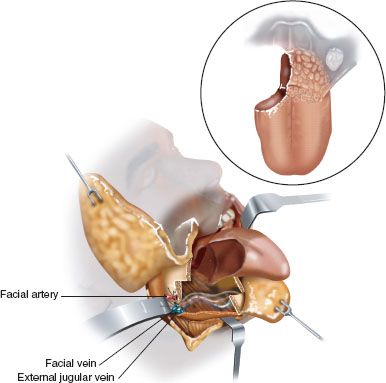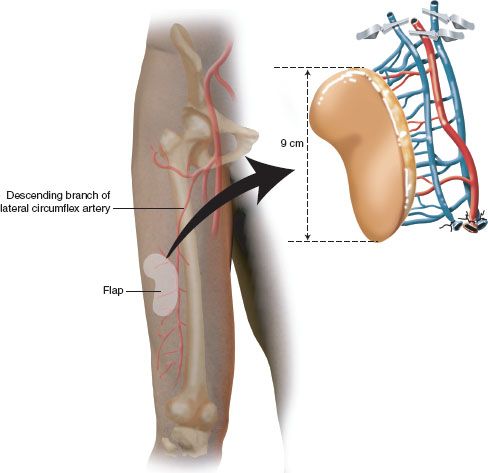FIGURE 12.1 Base of tongue tumor exposure via mandibulotomy. Tumors can also be removed through transhyoid or transoral resection.

FIGURE 12.2 Resection of the tumor of the BOT. Flap design should be 30% wider than the width of the defect to provide adequate soft tissue bulk.

FIGURE 12.3 ALTF designed to include perforators from the descending branch of the lateral femoral circumflex artery.
With the patient in the supine position, a line is drawn from the superolateral patella to the anterior superior iliac spine. A handheld Doppler is used to mark the position of the perforators. The perforators usually lie within a circle with a diameter of 5 cm from the midpoint of this line. The flap is designed as an oval centered on two to three of these perforators with the long axis of this oval parallel to the long axis of the thigh. The L-shaped tissue to be used is designed within this oval. The flap elevation begins with an incision of the medial side of the flap. Care should be taken to ensure that the initial incision is generously medial so as not to end up lateral to the perforators supplying the flap. Dissection is carried down to the fascia of the rectus femoris muscle. Dissection can then proceed laterally in a suprafascial or subfascial plane depending on the surgeon’s preference to harvest a fasciocutaneous or cutaneous flap. Dissection is carried meticulously laterally to identify either the septocutaneous perforators in the septum between the rectus femoris and the vastus lateralis or the musculocutaneous perforators piercing the vastus lateralis muscle lateral to the intermuscular septum. If the perforators are septocutaneous, the dissection proceeds easily along the medial side of the septum between the muscle bellies to identify the pedicle. If the perforators are musculocutaneous, the surgeon follows the septum to expose the pedicle, and then the medial side of these perforators is finely dissected through the muscle to their takeoff from the pedicle. Care is taken to preserve a thin cuff of muscle over the perforators to protect their integrity. Dissection of the perforators and the pedicle is easiest if it proceeds from distal to proximal. The perforators give off branches to the surrounding vastus lateralis on their lateral and posterior sides, and these branches must be clipped if the muscle is not to be included in the specimen. Alternatively, a cuff of vastus lateralis muscle can be harvested with the flap by incising the muscle lateral and posterior to the perforators after the circumferential incision of the skin flap.
After identification of the perforators and pedicle, the incision is completed around the skin paddle, and dissection is carried through the lateral vastus lateralis fascia. The distal continuation of the descending branch of the lateral circumflex femoral artery is clipped and divided. Dissection continues by freeing the perforators or muscle completely from their lateral and posterior attachments all the way to the pedicle, and then the pedicle is raised from distal to proximal with care to clip and divide the medial branches supplying the rectus femoris muscle. The flap elevation continues to the origin of the descending branch of the lateral femoral circumflex artery. Care should be taken to support the weight of the flap so as not to put tension on the pedicle during elevation. The flap can be left in situ without vessel division until the tumor extirpation is complete and the insetting for reconstruction can begin.
Stay updated, free articles. Join our Telegram channel

Full access? Get Clinical Tree


